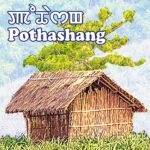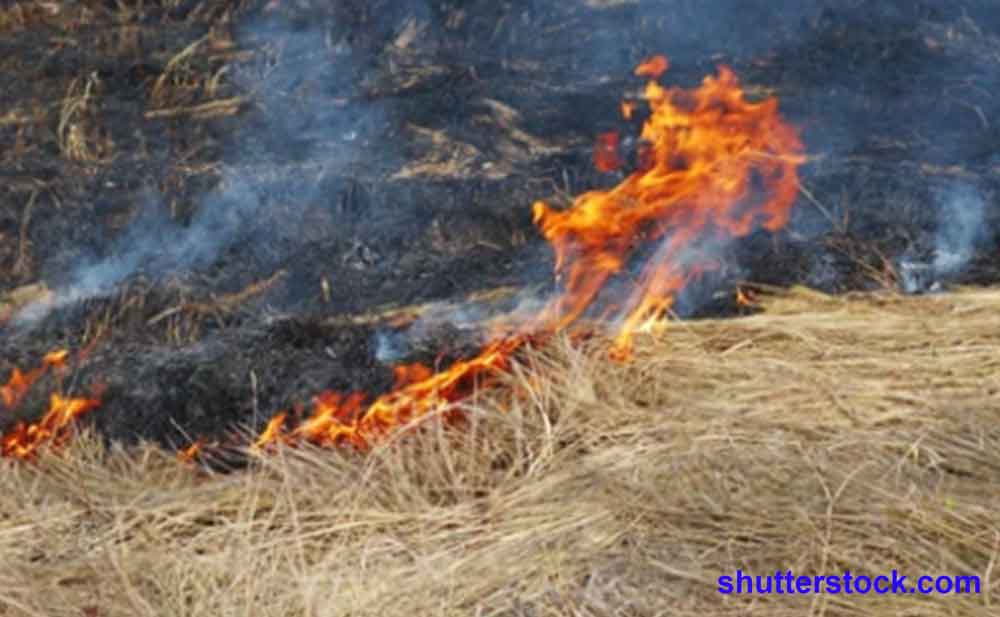In Manipur, it’s high time for harvesting. Everywhere long spiral smog are seen from hay straw burning. But straw burning is illegal and it affects soil fertility, moisture, organic matter, microbial population and pollute air, leading to the environmental degradation.
The unhealthy acts of straw burning were not seen in the past. On the harvesting day itself, people used to make bundles & collect to heaps in their homesteads for fodder and other purposes. But now people hardly rear cattle and also due to lack of spaces, hay straw are burnt to save labour, time and wages. People also have less knowledge about the benefits and environmental determinants from the straw burning. Thus, burning at the harvesting site itself is a common practice in the state and country.
Hay straw burning reduces visibility, worsening air quality and endangering public health. The added carbon from straw burning and the heat it produces reduce soil fertility and increase erosion. Burning leads to a rise in ground temperature, as a result, the soil dries up, necessitating additional water for irrigation. Livestock, too, is impacted by crop burning. It has been found that milk production falls up to 50% during the two months of stubble burning.
Hay straw burning decreases soil’s nitrogen, 25% of phosphorus, 20% of potassium and 5-60% of sulfur. A study on straw burning, 84.5 percent of people were suffering from health problems due to the increased incidence of smog. 76.8 percent of people expressed eye irritation, 44.8 percent in the nose and 45.5 percent in throat irritation. Another study by the Institute for Social and Economic Change, Bengaluru, found that every year in rural Punjab people spends Rs 7.6 crore on treatment for ailments caused by stubble burning.
The practice of stubble burning around October raises the concentration of particulate matter (PM) in the air to 1,000 micrograms per cubic meter. This particulate pollution in Delhi’s air spikes 20 times above safe levels given by WHO. Every year in North India during October and November the risk of getting a respiratory infection goes up by thrice as much as any other season.
The country’s rice production is about 8 tons /ha. Rice straw burning showed a release of 11 tons of CO2-equivalent per ha of land. Our country produces 152.2 million tons of rice and126.6 million tons of rice straw and 60% of them are burnt on the field annually.
When straws are scattered in the field during land preparation, they maintain soil’s nutrients and moisture. Every tons of rice straws can increase soil’s nutrients such as nitrogen, phosphorus, potassium, sulfur, silicon, and carbon. They also preserve the biodiversity of microorganisms that helps in nutrient cycling and efficient fertilizer utilization. Rice straws can also be used as mulch to protect the roots of the plants from heat and cold and reduce the evaporation rate. They also prevent weeds to grow in the paddy field.
In Manipur in absence of viable industries, agriculture is the main occupation with about 82 % of the total populations. Major part of state’s domestic product and employment up to 22.13% (2011 census) of the work force are in agricultural sector. Out of 22,327 sq.km geographical area, 12.98% is used for cultivation and 52% of it is confined in the valley. The total cultivated area of the state is about 2,89,500 ha in which about 82% are utilized for paddy.
A rough grain to straw ratio is about 1.0 to 0.8. In Manipur, the average rice yield is as high as 6.2 to 6.6 tons per ha or pari and the subsequent hay stubble production is about 5.2 tons. Therefore, our state produced 15,05,400 tons of hay straw annually.
Incineration of agricultural residue contributes to 7% of total PM2.5 emissions in the country. Rice fields produce around 22,289 gigagrams of residue annually and 13,915 gigagrams (62.42%) is set on fire. Haryana and Punjab contribute to 48% of the total stubble burning and releases 4,47,19,000 kilogram of total particulate matter (TPM) in India.
Burning crop residue is a crime under Section 188 of the IPC and under the Air and Pollution Control Acts, 1981. National Green Tribunal directs all state governments to take up for coercive and punitive action to the violators of stubble burning. The penalties are; farmers with below 2 acres land while on burning have to pay Rs. 2500, 2 to 5 acres for Rs. 5000 and more than 5 acres for Rs. 15000 as the environmental compensation. But in Manipur no such implementation is seen. In the other parts of the country, the farmers still burnt and prefer to pay the fines because paying fines save them more than to keep the NGT norms. Therefore, it is important to address their fundamental problems.
While on hay stubble burning, the loss of nutrients per ha amounts to 339 kg Nitrogen (N2), 6 kg Phosphorous (P), 140 kg Potassium (K) and 11 kg Sulphur(S) and many soil beneficial nutrients. Therefore with this rate, the total loss of nutrients in Manipur would be around 80.50 million tons N2, 1.42 million tons P, 33.22 million tons K and 2.61 million tons of Sulphur over and above many more important trace elements annually. The heat while on straw burning penetrate about 1 cm into the soil, elevating the temperature from 33.8°C to 42.2°C killing the bacterial, fungal and earthworm populations which enhance soil fertility.
The amount of greenhouse gases emitted, when 1 ton of stubble is burnt are 2 kg of SO2, 60 kg CO, 4-7 kg CH4, 1460 kg of CO2, 3 kg particulate matters and 199 kg of ash. These are the pollutants that hamper the climate which hindered our seasonal rainfall every year. At the same time, if we could allow them to decompose without burning somewhere at a corner of the paddy field, then the soil could get back 156 – 170 kg Nitrogen, 10.15 – 20.75 kg Phosphorus, 66 – 70 kg Potassium and 5 – 5.70 kg Sulphur from the hay straw of 1.25 acre paddy field. Thus, the total nutrients saving in Manipur would be around 113.6 million tons of NPKS annually. While burning the heap up stubble near the trees along the roadside also kill the valuable plants.
To save hay straw, state government may plan to establish the industries which utilize the hay straw for various purposes, like producing ethanol, paper and packaging material, biochar, compost, mushroom, fuel-briquette, fuel-pellets, pulp, animal-feed, eco-panel, erosion-control material and in-situ addition in conservation agriculture. The other method involves use of hay straw for biomass energy plants to generate electricity. In Punjab, thirteen such plants have been established. In Manipur also, we may innovate for such power generating plants which will surely reduce the environmental problems and social impacts.
Rearing of cattle is another option, because hay straw is a good fodder for cattle. Mushroom cultivation also known as protein cultivation is one of the most prospective eco-friendly practices to fight unemployment and malnutrition. Rice straw which contains 41% cellulose, 14% lignin, 0.8% nitrogen, 0.25% P2O5, 0.3% K2O, 6% SiO2 and with pH 6.9 is best for mushroom cultivation. The waste vermicompost is one of the best organic fertilizer.
The soil health is our future life. While the plants are stout and strong, no disease including wahik can attack. Therefore let’s not burn the hay straw but utilize it to uplift the rural economy and to save the environment.
- Munal Meitei)
Environmentalist, email-nmunall@yahoo.in













